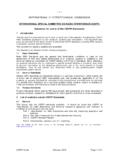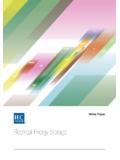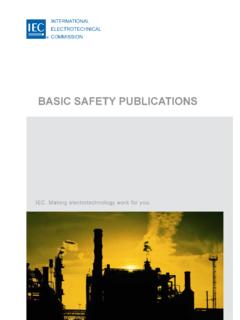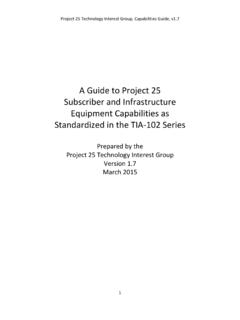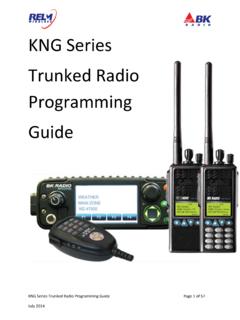Transcription of Factory of the future - Welcome to the IEC
1 White Paper . Factory of the future Executive summary By tradition, manufacturing has been thought of automation. Over time, the food industry as to be a process that turns raw materials into well as pharmaceutical and other manufacturing physical products, and the Factory , in managing companies has also heavily relied on automation to fragmented communications protocols and produce more and at lower cost. This often results automation practices, is the structure where in higher end quality and reliability throughout the manufacturing happens. Today, drivers such assembly chain to the advantage of the consumer. as technology, sustainability, optimization and The ultimate goal of the Factory of the future is the need to meet customer demands have once to interconnect every step of the manufacturing again encouraged the transformation of the process. Factories are organizing an unprecedented manufacturing industry, to become adaptive, fully technical integration of systems across domains, connected and even cognizant of its own power hierarchy, geographic boundaries, value chains quality.
2 This transformation is characterized by the and life cycle phases. This integration will only be globalization of value chains in organizations, with a success if the technology is supported by global the goal of increasing competitive advantages, consensus-based standards. Internet of Things creating more value add-ons and reducing costs (IoT) standards in particular will facilitate industrial through comprehensive sourcing. In support of automation, and many initiatives (too many to list this notion, one of the most significant trends in here) in the IoT standardization arena are currently manufacturing is the makeover from industrial underway. To keep up with the rapid pace of Ethernet and industrial wireless communications advancing technology, manufacturers will also need to that of improved information technology (IT). to invest in both digital technologies and highly solutions involving the union of conventional skilled technical talent to reap the benefits offered automation with cyber-physical systems combining by the fast-paced factories.
3 Worker safety and communications, information and communication data security are other important matters needing technology (ICT), data and physical elements and constantly to be addressed. the ability to connect devices to one another. This IT transformation, which shifts the manufacturing So what will the Factory of the future look like and process from a patchwork of isolated silos to a how will it be put into action? This White Paper will nimble, seamless and fully integrated system of assess the potential worldwide needs, benefits, systems (SoS) matching end user requirements in concepts and preconditions for the Factory of the the manufacturing process, can be described as future , while identifying the business trends in Factory of the future (FoF). related technologies as well as looking at market readiness. The advantages of having automated systems have been quickly recognized by industry. Due to the Section 2 leads with the current manufacturing rapid evolution of IT in the second part of the 20th environment and its evolution across the centuries.
4 Century, engineers are able to create increasingly The benefits of having multiple, bi-directional complex control systems and integrate the Factory value chains are essential as well as supporting floor. The automotive industry, for instance, has information optimization across organizational been transformed radically by the development boundaries. 3. Executive summary Section 3 provides a brief background on manufacturing paradigms throughout history Acknowledgments and examines various regional concepts of This White Paper has been prepared by the new manufacturing initiatives, their underlying Factory of the future project team in the IEC Market technologies and preconditions and their impact Strategy Board (MSB), with a major contribution on different facets of the manufacturing area. being furnished by the project partner, the Section 4 examines the driving technologies for Fraunhofer Institute for Manufacturing Engineering implementation of Factory of the future concepts.
5 And Automation IPA. The project team met on Technical challenges and preconditions many 3 occasions: October 2014 in Cleveland, January things are promised early, but take time to become 2015 in Stuttgart and April 2015 in Pittsburgh, and existent are also underscored as well as how to held a number of on-line conference calls. The enable the necessary technologies. project team includes: Section 5 balances the adoption of new Mr. Daryll Fogal, Project Leader, IEC MSB. technologies with the prerequisites for market Member, Tyco International readiness. Ms. Ursula Rauschecker, Project Partner Leader, Fraunhofer IPA. Section 6 envisages the future landscape, with consideration being given to enabling technologies Mr. Peter Lanctot, Project Administrator, IEC. as well as some of the specific challenges involved. Mr. Andreas Bildstein, Fraunhofer IPA. Section 7 concludes with a list of recommendations Mr. Mark Burhop, Siemens for addressing the requirements related to data, Dr.
6 Arquimedes Canedo, Siemens people, technology and standards for factories of Mr. Kai Cui, Haier Group the future . Mr. Teruaki Ito, Mitsubishi Electric Mr. Benoit Jacquemin, Schneider Electric Mr. Kevin J. Lippert, Eaton Corporation Mr. Andy Macaleer, SAP. Mr. Alec McMillan, Rockwell Automation Dr. Youichi Nonaka, Hitachi Mr. Noritaka Okuda, Mitsubishi Electric Mr. Ken Sambu, Mitsubishi Electric Ms. Veronika Schmid-Lutz, SAP. Mr. Haibo Shi, Shenyang Institute of Automation (CN). Dr. Kazuhiko Tsutsumi, IEC MSB Member, Mitsubishi Electric Mr. Chris G. Walker, Eaton Corporation Mr. Chunxi Wang, Instrumentation Technology and Economy Institute (CN). Mr. Yang Wang, Huawei Technologies Ms. Shi Xiaonan, Mitsubishi Electric 4. Table of contents List of abbreviations 7. Glossary 9. Section 1 Introduction 11. Scope of this White Paper 11. Section 2 Current manufacturing environment 14. Section 3 Concepts of the Factory of the future 17.
7 Open value chain 17. Flexible production 18. Human-centered manufacturing 18. Business models 20. Crowdsourcing 20. Anything-as-a-service 21. Symbiotic ecosystem 22. Local initiatives 22. Advanced manufacturing (US) 23. e- Factory (Japan) 23. Industrie (Germany) 24. Intelligent Manufacturing (China) 25. Section 4 Driving technologies 26. Technology challenges/needs 26. Connectivity and interoperability 26. Seamless Factory of the future system integration 28. Architecture for integrating existing systems 28. Modelling and simulation 29. Security and safety 30. 5. Table of contents Enabling technologies 32. Internet of Things and machine-to-machine communication 33. Cloud-based application infrastructure and middleware 34. Data analytics 35. Smart robotics 37. Integrated product-production simulation 38. Additive manufacturing/3D printing 40. Additional Factory of the future technologies 40. Section 5 Market readiness 41. Implementation of a systems perspective 41.
8 Overcome resistance to change in traditional production environments 41. Financial issues 42. Migration strategies 42. Section 6 Predictions 43. Section 7 Conclusions and recommendations 45. General 45. Data 46. People 46. Technology 47. Standards 48. Annex A References 49. 6. List of abbreviations Technical and AI artificial intelligence scientific terms AIM application infrastructure and middleware AM additive manufacturing AVM adaptive vehicle make BOM bill of materials CAD computer-aided design CAx computer-aided technologies CEP complex event processing CNC computer numerical control CPPS cyber-physical production system CPS cyber-physical system DCS distributed control system EDI electronic data interchange ERP enterprise resource planning ESP event stream processing FoF Factory of the future HMI human-machine interface ICT information and communication technology IoT Internet of Things IT information technology M2M machine to machine MEMS microelectromechanical system MES manufacturing execution system NFC near field communication PLC programmable logic controller QMS quality management software R&D research and development ROI return on investment 7.
9 List of abbreviations SCADA supervisory control and data acquisition SIM subscriber identity module SoS system of systems WBS work breakdown structure XaaS anything-as-a-service Organizations, AMO Advanced Manufacturing Office institutions and AMP Advanced Manufacturing Partnership companies IEC International Electrotechnical Commission IIC Industrial Internet Consortium MSB Market Strategy Board (of the IEC). NCOIC Network Centric Operations Industry Consortium SMLC Smart Manufacturing Leadership Coalition VDMA Verband Deutscher Maschinen- und Anlagenbau (German Engineering Association). ZVEI Zentralverband Elektrotechnik- und Elektronikindustrie 8. Glossary cyber-physical systems horizontal integration CPS supply chain integration into a holistic IT landscape smart systems that encompass computational between different stages of production and the components ( hardware and software) and respective resource and information flow within physical components seamlessly integrated and a Factory and across companies along the value closely interacting to sense the changing state of chain the real world vertical integration Internet of Things information integration and system interoperability IoT across technological and business levels in pro- infrastructure, technologies and applications that duction and logistics (sensor, control, production, bridge the gap between the real world and the manufacturing, execution, production planning virtual world and management level).
10 Additive manufacturing fully automated production of a product from a virtual model through 3D printing or use of similar technologies 9. Section 1. Introduction What will the production world of the future participating in the value chain, as well as look like? How will humans and machines providing the ability to deduce the optimal value communicate with each other? Will our working chain processes from this data at the demand of worlds be adaptable to our needs? In the Factory the individual customer. Through the interaction of the future humans will have to come to terms of humans, objects and systems a dynamic, real- with an increasingly complex world of processes, time optimized and self-organizing value chain machines and components. This will require new will evolve. This value chain can be multi-vendor operating concepts for optimized human-machine capable and can be adjusted for different business operations. Nimble, adaptive and intelligent aims, such as costs, availability and resource manufacturing processes will be the measurement consumption.

